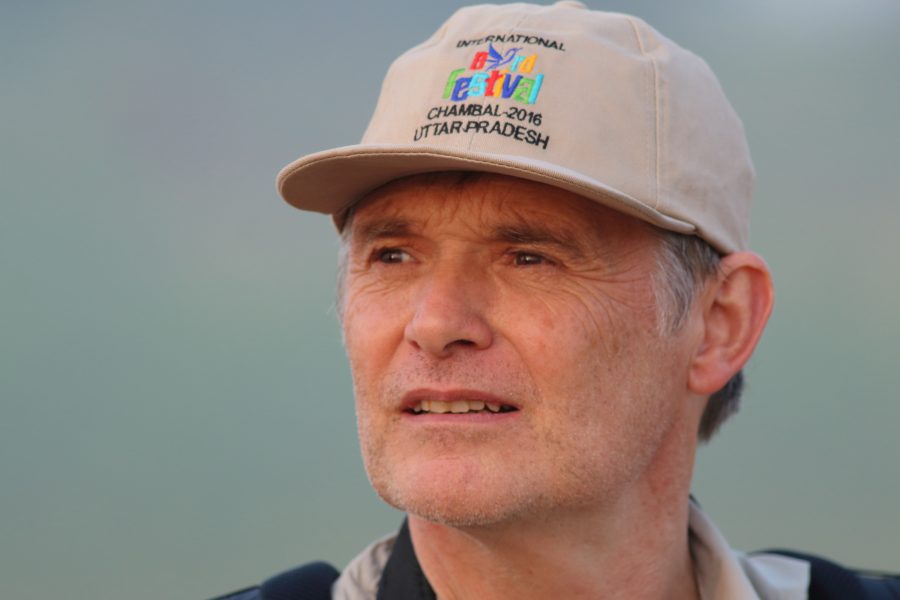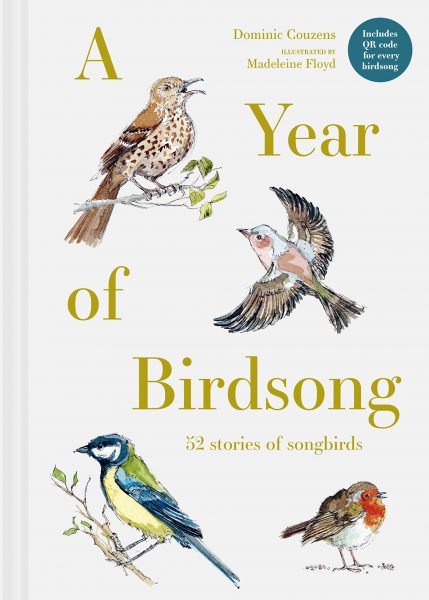An interview with Dominic Couzens on his book ‘A Year of Bird Song’ illustrated by Madeleine Floyd published by Batsford.
Reproduced with permission from the Quarterly Newsletter (Issue No. 271, December 2023) of the London Natural History Society.
Dominic Couzens is an award-winning nature writer, with over 40 book titles to his name, as well as many hundreds of articles for magazines and the national press. He has regular columns in Bird Watching Magazine, The RSPB magazine and Water Life (WWT). He has been fortunate enough to travel the world writing about wildlife and some of those experiences inspired this book.

How did this book come about?
It might seem odd to admit that a book about British insects inspired a book about bird song around the world, but that’s what happened. And it was all about the QR codes that were used for Grasshoppers and Crickets in the WildGuides book “Britain’s Insects.” It suddenly occurred to me that people might love reading about bird songs, and at the same time have access to sound files of those very same songs on their smartphone.
That is really how this book was born. It covers 52 weeks of the year, with a short essay (about 600 words) about one bird song per week – so, for example, we have Song Thrush in January and Great Tit in December. Although the coverage is worldwide (we have Musician Wren from the Amazon and Common Hawk-Cuckoo from India, for example), most of the songs are from Europe and North America. All the favourites are there – Nightingale, Lyrebird, Tawny Owl, Robin and so on.
Each essay is very different, and variously cover poetry, folk tales, lots of science, even a few personal tales. It’s a Son et Lumiere for bird song. I feel incredibly fortunate to have worked with the amazing Madeleine Floyd, who brings a touch of artistic class to every entry.
How many years was this book in the making?
Not many. It probably took less than a year from idea to publication. I wrote it very quickly – it’s one of my very favourite subjects and flowed relatively easily.
What do you want to achieve with this book?
Apart from making a fortune and winning multiple awards, you mean? (Ha, ha!). It’s very simple. I just adore bird songs. I have been involved with them for many years, often teaching people how to recognise. But even after 30 plus years of writing, I still find few things more delightful than just taking a still moment and listening.
There are two aims, if you like. While bird song is beautiful, it is also fascinating and extremely well studied, and there is enough out there to make it a subject of great intrigue. I do hope that people will learn a lot about bird songs.
Secondly, of course, there is a lot of interest at the moment about how bird songs can contribute to people’s well-being. There is something extremely humbling in the thought that somebody might read the book and listen and actually feel the stresses of the day ameliorating somewhat. That would be wonderful.
Is there a fun fact or something amazing you learnt during the writing of the book?
The research is always the best part of writing a book, and bird sounds lend themselves well to memorable facts. Here are a few examples, which your readers are only allowed to see if they promise to buy the book.
Agreed? The White Bellbird can call at 125dB, which is as loud as a rock concert, and nobody knows why they don’t deafen themselves; male and female Cardinals sing in code, passing instructions; in a few species, females and now known to sing more than males; and Mockingbirds sing completely different songs in spring and autumn. There are many, many more, of course.
Were there any memorable moments during the course of writing this book?
Finishing a book is always a great moment, especially if you hit the deadline. It’s also always a good feeling when you know at least one book has been sold (happily, we’ve since gone to reprint) or see it in the shops.
However, as you yourself know, Gehan, writing a book is one of the least glamorous things you can do. You lose bits of your life, stay indoors for hours on end with your mind ablur and incapable, go through endless proof stages which feel like pulling teeth, and then with intense trepidation see your work go public in a way similar to launching a child into the adult and you feel deeply vulnerable. I’ve been through this process over 40 times, which probably explains why I’m a little unhinged.
For anyone who wishes to pursue this topic more, are there any online resources you would recommend?
There are many superb websites containing readily available bird song. A good place to start is the RSPB’s own (www.rspb.org.uk) where there are sections on each British bird with some recordings. Everyone should have the Merlin app. Not only does it have access to every species in the world, it also has a facility to help identify birds for you. It’s incredible how things have changed.
Information about every bird in the world, as well as multimedia, are available at the subscription site https://birdsoftheworld.org/
And no resource has more recordings of birds than xeno-canto https://xeno-canto.org/ Not content with having multiple recordings of most birds in the world, it has now diversified to other wildlife, including bats. Subject to the Creative Commons licensing terms, we took the recordings for the book from here.

